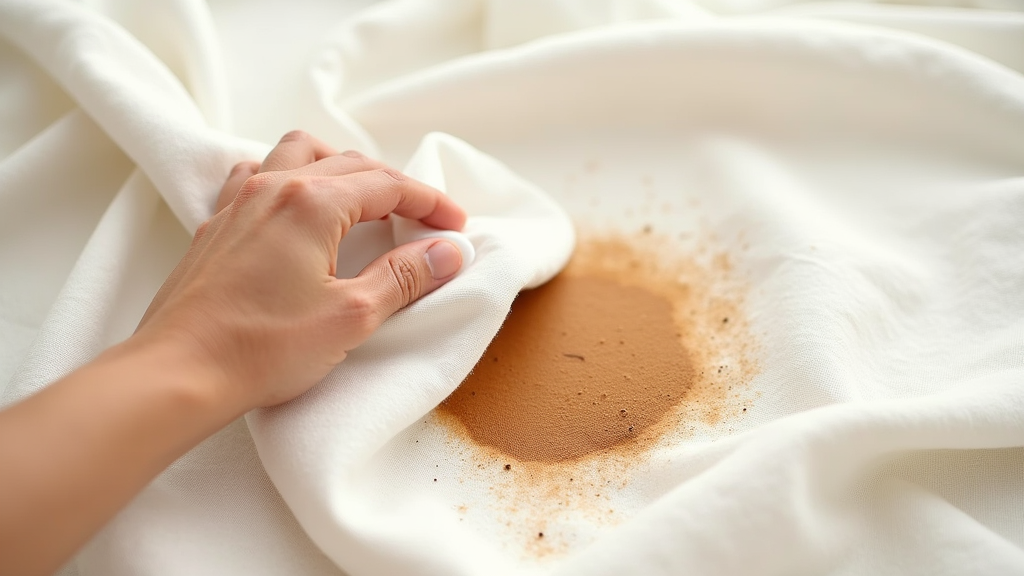Table of Contents
- Effectively Removing Coffee Stains from Linen Fabrics
- Understanding How to Remove Coffee Stains from Linen
- Detailed Guide: Removing Coffee Stains from Linen
- Essential Materials for Treating Linen Coffee Stains
- Initial Steps for Linen Stain Removal Success
- Important Considerations Before Cleaning Linen
- Immediate Action: Blotting Fresh Coffee Spills
- Rinsing the Coffee Stain with Cold Water
- Pretreating the Linen with Mild Detergent
- Washing Linen After Coffee Stain Treatment
- Alternative Stain Removal Methods for Linen
- White Vinegar Soak for Stubborn Coffee Stains
- Using Baking Soda Paste on Linen Fabrics
- Boiling Water Method for Removing Coffee Stains
- Troubleshooting Persistent Coffee Stains on Linen
- Preventing Coffee Stains on Linen and Ongoing Maintenance
Effectively Removing Coffee Stains from Linen Fabrics

Why Immediate Action Matters for Coffee Stained Linen
Linen, prized for its delicate nature, demands particular care when accidents happen. Coffee stains, notorious for their stubbornness, pose a significant threat to this beautiful fabric. Prompt and appropriate stain removal is crucial to preserving linen’s inherent quality and aesthetic appeal, preventing permanent damage and discoloration.
Understanding Linen and Coffee Stain Challenges
Linen is a natural textile crafted from the fibers of the flax plant. Celebrated for its robust strength, enduring durability, and exceptional absorbency, it’s a popular choice for clothing and home goods. Unfortunately, coffee stains are a frequent household occurrence, often finding their way onto our beloved linen items.
Mastering Coffee Stain Removal and Linen Care
This guide will equip you with effective strategies for successfully eliminating coffee stains from your linen possessions. We’ll also delve into preventative measures to minimize the risk of future stains and provide essential linen maintenance techniques to keep your fabrics looking their best for years to come.
Understanding How to Remove Coffee Stains from Linen
Linen Fabric Properties Affecting Coffee Stain Removal
Linen is known for its strength and durability, but it’s also highly absorbent. This absorbency means that coffee stains can quickly penetrate the fibers, making prompt action essential. Remember that heat can set the stain, so avoid using hot water or a hot iron until the stain is completely removed.
Critical Factors for Coffee Stain Removal on Linen
Several factors influence how easily you can remove a coffee stain from linen. Fresh stains are much easier to treat than old ones. Also, the presence of cream or sugar in the coffee complicates the process. Always consider these factors when deciding on your cleaning method.
Necessary Supplies for Treating Coffee Stains on Linen
To effectively remove coffee stains from linen, you’ll need a few key items. Gather clean, white cloths or paper towels to blot the stain. Cold water is essential, along with a mild detergent or laundry soap. Other useful agents include white vinegar, baking soda, lemon juice, and hydrogen peroxide (a 3% solution). A soft-bristled brush can also be helpful for gently agitating the stain.
Linen’s Sensitivity and Safe Stain Removal Techniques
Linen can be a delicate fabric, so it’s important to avoid harsh chemicals that could damage the fibers or cause discoloration. Always test any cleaning solution on an inconspicuous area first. Remember that gentle, patient cleaning is often more effective than aggressive scrubbing.
Detailed Guide: Removing Coffee Stains from Linen

Essential Materials for Treating Linen Coffee Stains
Before you begin tackling that unsightly coffee stain on your linen, it’s crucial to gather the right materials. Having everything at hand will make the process smoother and more effective.
- Clean, white cloth or sponge
- Cold water
- Mild detergent or laundry soap
- Optional: Stain remover, hydrogen peroxide, lemon juice
Initial Steps for Linen Stain Removal Success
Proper setup is key to preventing further damage and ensuring a successful stain removal process. Here’s how to prepare your workspace and the linen item.
- Protect the work surface with a clean towel.
- Gather all necessary materials within easy reach.
Important Considerations Before Cleaning Linen
Before applying any cleaning solution to your linen, keep these important considerations in mind to avoid damaging the fabric.
- Always test cleaning solutions on a hidden area first to check for colorfastness.
- Work from the back of the fabric to push the stain out rather than further embedding it.
Immediate Action: Blotting Fresh Coffee Spills
The moment coffee hits your linen, quick action is crucial. Here’s how to minimize the damage immediately.
Blot the stain immediately with a clean, white cloth or paper towel. Avoid rubbing, which can spread the stain and make it harder to remove.
Rinsing the Coffee Stain with Cold Water
After blotting, the next step is to rinse the stained area to dilute the coffee and prevent it from setting.
Rinse the stained area under cold running water. Allow the water to flow from the back of the fabric to help flush out the stain.
Pretreating the Linen with Mild Detergent
Pretreatment helps to loosen the stain and prepare it for washing. Here’s how to pretreat a coffee stain on linen effectively.
Apply a small amount of mild detergent or laundry soap directly onto the stain. Gently rub it in with your fingers or a soft-bristled brush in a circular motion. Let it sit for 5-10 minutes.
Washing Linen After Coffee Stain Treatment
Once you’ve pretreated the stain, it’s time to wash the linen. Follow these steps for the best results.
Launder the linen according to the care instructions on the label. Check for stain removal after washing. Repeat treatments if necessary before drying, as drying can set the stain.
Alternative Stain Removal Methods for Linen
If mild detergent isn’t enough, consider these alternative methods for stubborn coffee stains on linen.
- Hydrogen Peroxide:Apply to the stain, rub gently, let sit for 10 minutes, rinse with cold water, then wash. Use a 3% solution.
- Lemon Juice:Apply juice to the stain, rub gently, let sit for 5-10 minutes, rinse with cold water, and then wash.
White Vinegar Soak for Stubborn Coffee Stains
For persistent coffee stains, a white vinegar soak can work wonders. Here’s how to do it.
Mix equal parts white vinegar and cold water. Soak the stained area for about 30 minutes. Rinse with cold water.
Using Baking Soda Paste on Linen Fabrics
Baking soda is a gentle abrasive that can help lift coffee stains. Learn how to make and use a baking soda paste.
Make a paste with baking soda and cold water. Rub gently onto the stain. Let it sit for 15 minutes. Rinse with cold water.
Boiling Water Method for Removing Coffee Stains
This method requires caution but can be effective for certain types of linen. Always test a hidden area first.
Stretch the stained area over a bowl, secure with a rubber band. Pour boiling water through the stain from a height of 2 to 3 feet. Test on an inconspicuous area first to ensure the fabric is colorfast and won’t be damaged.
Troubleshooting Persistent Coffee Stains on Linen
Sometimes, a stain just won’t budge. Here are some troubleshooting tips for dealing with stubborn coffee stains.
For old stains, repeat the pretreatment and washing steps multiple times. If the stain persists, consider professional cleaning to avoid damaging the linen.
Preventing Coffee Stains on Linen and Ongoing Maintenance
Immediate Action: The Best Coffee Stain Prevention
The single most effective strategy in battling coffee stains on linen is to act swiftly. Fresh coffee stains are far easier to remove than those that have had time to set into the fabric’s fibers.
- Act Quickly:Address spills the instant they happen. The longer the coffee sits, the tougher it becomes to extract.
- Blot, Don’t Rub:Resist the urge to rub the stain. Rubbing only spreads the coffee and drives it deeper into the linen. Always blot gently with a clean cloth or paper towel.
- Spot Test Solutions:Before applying any stain removal product, test it on an inconspicuous area of the linen to ensure it doesn’t discolor or damage the fabric.
- Apply Stain Repellent:Consider using a fabric stain repellent specifically designed for delicate fabrics like linen. This creates a protective barrier, making it harder for coffee to penetrate the fibers.
- Beware Coffee Additives:Be extra cautious with coffee containing cream and sugar. These additions can complicate stain removal due to the added fats and sugars that bind to the fabric.
- Use Spill-Proof Mugs:Especially when enjoying coffee near linen clothing or upholstery, opt for travel mugs or spill-proof containers.
- Use Tablecloths and Placemats:Protect linen tablecloths and other surfaces with placemats or coasters when serving coffee.
Linen Care: Preventing Coffee Stains Permanently
Proper care and maintenance are crucial for preserving your linen items and preventing stains from becoming permanent fixtures.
- Follow Care Instructions:Always adhere to the specific washing and care instructions provided on the garment or item’s label. These instructions are tailored to the fabric composition and construction.
- Avoid High Heat Washing and Drying:High heat can cause stains to set and damage linen fibers. Use cooler temperatures for both washing and drying. Washing in cold water (30°C or 86°F) is generally recommended.
- Proper Linen Storage Prevents Stains:Store your linen items properly to prevent creasing and maintain their quality. Hanging them or storing them flat in a cool, dry place is ideal.
- Regular Cleaning Prevents Stubborn Coffee Stains:Regularly clean and maintain your linen items, even if they don’t appear visibly stained. This helps prevent any unnoticed spills from setting and becoming permanent.

